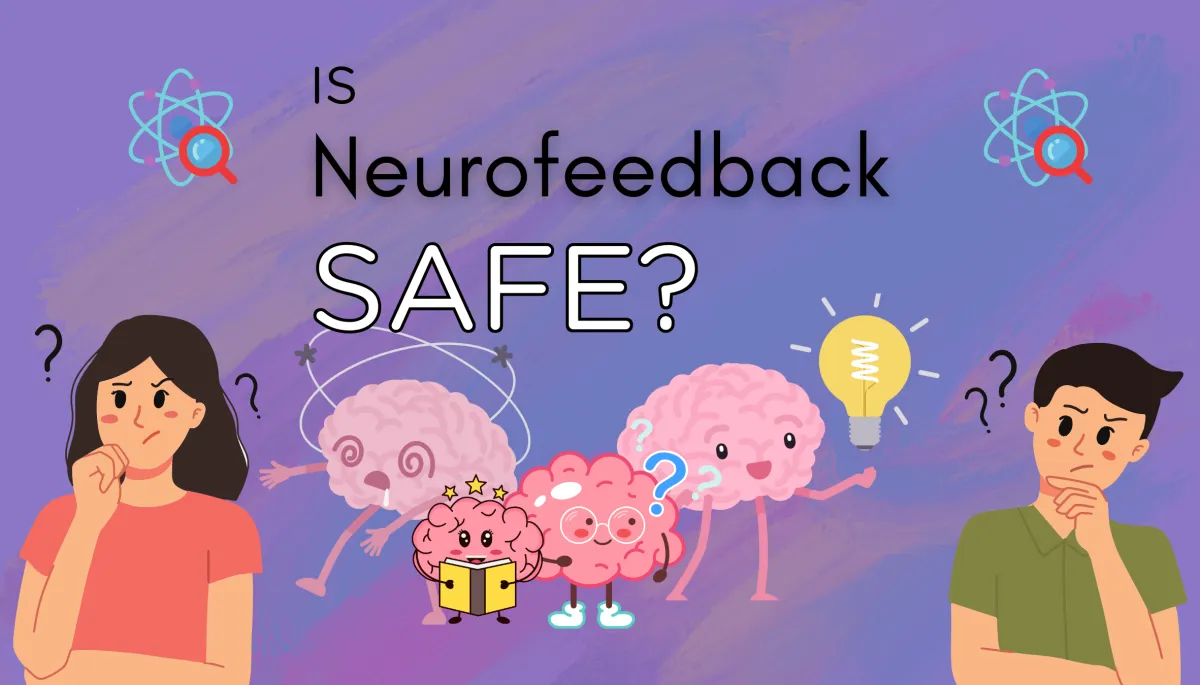General Inquiries: (587) 333-6349 - info@sanostate.com



Is Neurofeedback Safe?
“Neurofeedback leads to better outcomes for many conditions”
Is Neurofeedback Safe?
If you’ve never heard of Neurofeedback (NF) before, it can sound daunting, uncomfortable,

and maybe even scary. Don’t worry - you’re not alone. One of the most common questions we get is, “Is this safe?” Keep reading for an overview of NF, its side effects, and overall safety.
Understanding Neurofeedback:
Neurofeedback is a less widely-known treatment option in comparison to medication or talk therapy, but that doesn’t mean it’s something to fear. It is a non-invasive way of training the brain to behave differently and has been found to improve outcomes for many conditions, including ADHD, PTSD, and Insomnia. It works by monitoring electrical activity in the brain and reflecting it back at the client in real-time. Over time, the brain learns that certain changes in the environment are associated with specific activity patterns and adjusts its activity to better fit what the training program considers ideal for the individual. At Sano State, these “changes in the environment” are usually audio cues in specially created songs.
Are there side effects?
Like any treatment, Neurofeedback can have side effects; some people report headaches, fatigue, or anxiety. Generally, these are mild and temporary - as the client gets used to the treatment, they usually stop experiencing side effects. It’s important to note that not everyone will experience them; by virtue of its nature, NF is a highly individualized treatment method, and there is no real way of estimating whether someone will have side effects or not since every brain and life circumstance is different.
How can I reduce the risk of side effects?
The best way to reduce your risk of experiencing adverse effects from Neurofeedback is to choose a practitioner who is well-versed in the field, is up to date on new findings, and, most importantly - is someone you feel comfortable with. Often, side effects are a result of a training program that is not a good fit for what the individual needs; your practitioner should be open to revising your protocols if needed. Some other things you may choose include booking shorter sessions if fatigue is a problem, getting enough sleep, and being in a comfortable, relaxed state when going to a session.
What should I do if I experience side effects?
Firstly - don’t panic! For many people, starting Neurofeedback is a significant change in their lives and comes with a lot of added commitment, which can be stressful. It is not uncommon to have some initial side effects during the adjustment period. The best thing you can do is monitor the side effects and discuss them with your practitioner as soon as possible. From there, they can advise the best course of action for your unique needs.
So, is it safe?
Neurofeedback is primarily considered a safer alternative to treatments such as medication, which often has comparatively many side effects of higher severity. While there is always room in the field for new findings, the research has generally found that NF leads to better outcomes for many conditions and even improvement in overall cognitive abilities for clients without lasting side effects.
If you’d like to learn more about Neurofeedback or have any questions about side effects, please don’t hesitate to get in touch HERE or call us at 587-333-6349 💙
References
Enriquez-Geppert, S., Smit, D., Pimenta, M.G. et al. Neurofeedback as a Treatment Intervention in ADHD: Current Evidence and Practice. Curr Psychiatry Rep 21, 46 (2019). https://doi.org/10.1007/s11920-019-1021-4
Leem, J., Cheong, M. J., Lee, H., Cho, E., Lee, S. Y., Kim, G.-W., & Kang, H. W. (2021, October 11). Effectiveness, cost-utility, and safety of neurofeedback self-regulating training in patients with post-traumatic stress disorder: A randomized controlled trial. MDPI. https://www.mdpi.com/2227-9032/9/10/1351
Marzbani, H., Marateb, H. R., & Mansourian, M. (2016). Neurofeedback: A Comprehensive Review on System Design, Methodology and Clinical Applications. Basic and clinical neuroscience, 7(2), 143–158. https://doi.org/10.15412/J.BCN.0307020
Rogel, A., Guez, J., Getter, N. et al. Transient Adverse Side Effects During Neurofeedback Training: A Randomized, Sham-Controlled, Double Blind Study. Appl Psychophysiol Biofeedback 40, 209–218 (2015). https://doi.org/10.1007/s10484-015-9289-6
-
General Inquiries:
Our Locations:
Additional Resources:
About Us:
We strive for excellence in psychological treatment. We are committed to providing professional, caring, innovative, and research-based services.
© 2024 Sano State Taylored Psychology. All Rights Reserved.

